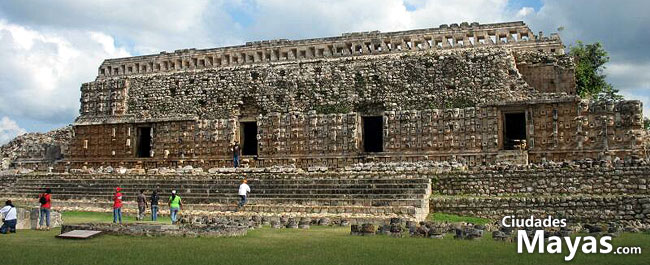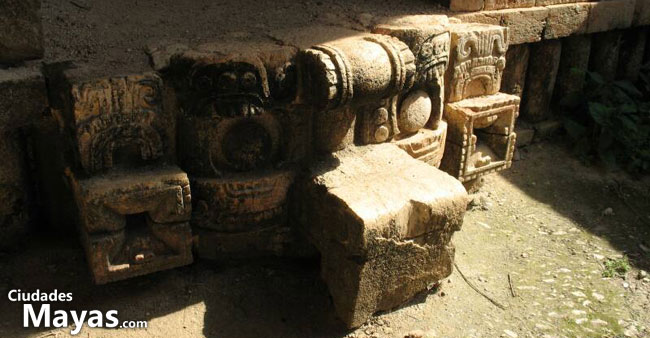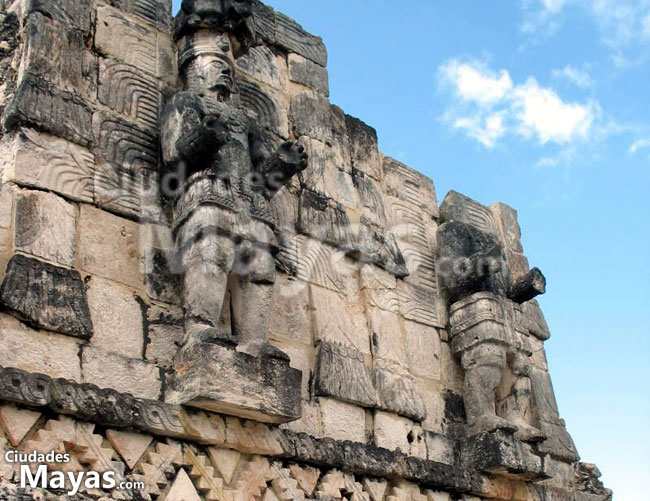Kabáh in the Yucatán
09 de Octubre 2015
It is part of an archeological conglomerate in the Yucatan Peninsula. Its major distinctive feature is the facade of the Temple of the Masks, with repetitive facial ornamentation of the god Chac, god of rain.


Palace of the Masks of Kabah
The set of archaeological sites has Puuc architectural characteristics. It is in the Kabah building where Codz Poop, called Palace of the Masks calls particular attention to its front cover stone face of the god Chac in a repetitive manner.It measures 45 meters long and although its form is simple, it is the large decoration of its facade which gives it prominent ornamental detail. It has four entries in its facade and each carries two indoor rooms one behind the other.

In total, there are ten inner chambers whose doors are accessible by stairs located on the front right. The trace of the construction of the steps is located in the south part ,and the total body structure aligned to the north.
The repetition of elements in a series reaches a prominent reputation to be more than 260 times the mask of so-called rain god (Chac). At the time, such repetition and their numbers are only a matter of speculation.
Chac's nose protrudes with a curvature toward the front like a trunk.
This highlights the entrance to the second chamber of the temple, which is located in a lower part and the prominence touches the floor in one step.

The Motionless Sovereign of Kabáh
En Kabah se encuentran personajes inmóviles a forma de efigies que se caracterizan por una expresión de absoluta rigidez. Estas robustas figuras humanas poseen lo que parece una corona, manos cuales ganchos y su rostro se cubre de cicatrices. Un fragmento exhibido en el Museo se ha denominado Rey de Kabah pues dichas características aluden a la realeza. Sobresale un detalle extraño y es lo que parece un bigote, una característica casi fuera de lugar para la apariencia propia de los nativos de América Central previo a la conquista, carentes de barba y bigotes de este tipo.
John Lloyd Stephens y Frederick Catherwood fueron los primeros en dar a conocer detalles de este emplazamiento. El primero (John Stephens) era un explorador americano originario de Nueva Jersey que se hizo acompañar por el arquitecto Frederick, excelente dibujante que plasmaría los primeros dibujos de las ciudades descubiertas.
Estos capturaron la escencia de los vestigios arquitectónicos ya carentes de su esplendor y rodeados de vegetación en ésa fecha, algunos incluso semi cubiertos.

Ubicación de Kabah
Se encuentra en la Península de Yucatán al sur de Mérida rumbo a Campeche. Es parte del conglomerado de sitios arqueológicos de Sayil, Uxmal, Labná y Xlapak, que se pueden visitar todos en un solo día. Esta proximidad y el fácil acceso entre sitios ha convertido a Kabah en parte de un circuito turístico bastante popular.Existen hospedajes en los poblados cercanos a los sitios arqueológicos. Quizá el más popular y turístico sea el de Uxmal, pues cuenta con hoteles a un costado del complejo arqueológico.
Cuenta con numerosas estructuras y la curiosa presencia de abundantes iguanas que pasean por los templos.
Publicaciones relacionadas:
- Izapa, ciudad maya en el Estado de Chiapas
- Museo de la Cultura Maya en Chetumal
- Kohunlich y sus mascarones
- Chichen Itzá maravilla del mundo
- Labná in the Yucatán
- Kinichkakmoo en Izamal
- Mayapán
- Tulum en Quintana Roo
- Uxmal en Yucatán
- Chicanná
- Mayapán maya city
- El Rey sitio arqueológico en Cancún
- Kabáh en Yucatán
- Sayil en Yucatán
- Ek Balam el Jaguar Negro
- Xlapak
- Cobá maya ruins
- Palenque zona arqueológica
- Xlapak ruins
- Tulum in Quintana Roo
Lee más publicaciones de:
Arqueología México
